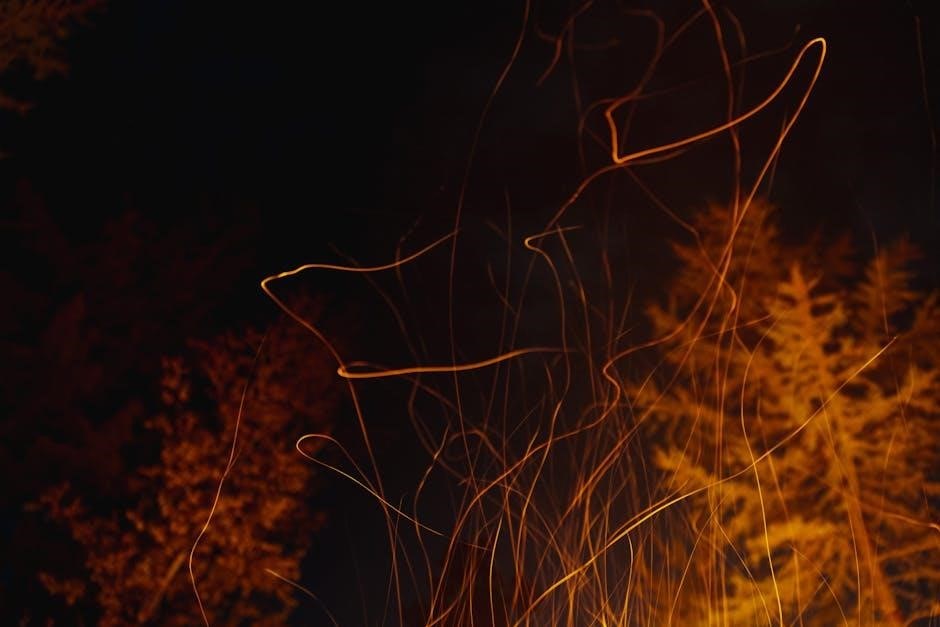Wilderness long-term survival requires mastering essential skills to thrive in nature. It involves understanding basic needs, preparing adequately, and cultivating a resilient mindset to overcome challenges effectively.
1.1 Understanding the Basics of Wilderness Survival
Wilderness survival begins with mastering the fundamentals: shelter, water, food, and fire. Prioritize these needs, as they are crucial for sustaining life. The rule of threes—3 minutes without air, 3 days without water, and 3 weeks without food—guides decision-making. Learning to identify edible plants, purify water, and build shelters is essential. Fire provides warmth, light, and a way to cook food. Understanding these basics ensures a strong foundation for long-term survival in harsh environments.
1.2 Importance of Preparation and Mindset
Preparation is key to wilderness survival, as it reduces panic and increases confidence. A well-thought-out plan, essential gear, and knowledge of survival skills are vital. Mental resilience is equally important; staying calm and resourceful can mean the difference between life and death. Cultivating a positive mindset helps navigate challenges, while adaptability ensures survival in unpredictable environments. Preparation and mindset together create a foundation for thriving in the wild, turning a desperate situation into a manageable one.

Essential Skills for Wilderness Survival
Mastering skills like shelter-building, fire-starting, water purification, and foraging is crucial for wilderness survival. These techniques ensure safety, sustenance, and the ability to navigate challenging environments effectively.
2.1 Building Shelter and Protection from Elements
Building a sturdy shelter is vital for protecting yourself from harsh weather conditions. Use natural shelters like caves or rock overhangs when available. If none exist, construct lean-tos or debris huts using branches and leaves. Ensure your shelter is waterproof and well-insulated to retain body heat. Clear the area of leaves and twigs to reduce fire risks. Elevate your shelter slightly to improve drainage and avoid water accumulation. Proper shelter protects from rain, wind, and snow, ensuring safety and comfort in the wilderness.
2.2 Starting a Fire Without Modern Tools
Starting a fire without modern tools is a critical survival skill. Use methods like flint and steel, bow drill, or hand drill to ignite tinder. Choose dry, standing dead wood for kindling, as it burns easily. Prepare tinder by shredding bark or leaves. Arrange logs in a teepee or log cabin structure for optimal airflow. Keep the fire small to conserve energy and resources. Fire provides warmth, light, and a way to cook food, essential for long-term survival in the wilderness.
2.3 Finding and Purifying Water Sources
Finding and purifying water is essential for survival. Locate sources like streams, ponds, or springs, ensuring they are free from contamination. Use methods like boiling, sand filtration, or solar disinfection to purify water. Collect morning dew or rainwater as alternative sources. Always avoid stagnant water and check for signs of pollution. While these methods may not remove all contaminants, they significantly reduce the risk of waterborne illnesses, making water safer for consumption in the wilderness.
2.4 Foraging for Edible Plants and Hunting
Foraging for edible plants and hunting are crucial skills for long-term survival. Learn to identify safe plants and avoid toxic species. Use tools like knives or traps for hunting small game. Ensure ethical practices and minimize waste. Cooking meat thoroughly prevents foodborne illnesses. Combine foraging and hunting to maintain a sustainable food supply, balancing nutrition and energy expenditure. These skills require patience, knowledge, and practice to master effectively in the wild.

Health and Safety in the Wilderness
Ensuring health and safety in the wilderness involves preventing injuries, managing wounds, and avoiding environmental hazards. Stay prepared and aware to maintain well-being during extended stays in nature.
3.1 First Aid and Wound Care
First aid and wound care are critical in wilderness survival. Preventing infections is key; clean wounds with safe water and apply antiseptics. Control bleeding using tourniquets or pressure. Keep wounds dry to promote healing. Neglecting these steps can lead to severe health issues. Always carry a basic first aid kit with essentials like bandages, antiseptic wipes, and gloves. Proper wound management ensures longevity in extreme environments.
3.2 Avoiding and Treating Wilderness Diseases
Avoiding wilderness diseases is crucial for long-term survival. Use insect repellent to prevent bites that may carry diseases like Lyme or malaria. Filter or boil water to avoid waterborne illnesses such as giardiasis. Vaccinations and proper hygiene are essential. Treat infections promptly with antibiotics if available. Recognize symptoms early, as delays can worsen conditions. Carry a medical guide to identify and manage diseases effectively, ensuring prolonged health in remote environments.
3.4 Protecting Yourself from Wildlife
Protecting yourself from wildlife is essential for survival. Avoid attracting animals by storing food securely and keeping a clean campsite. Make noise while hiking to prevent surprising wildlife. Carry bear spray or pepper spray as a deterrent. Stay calm during encounters and follow specific protocols for different species, such as backing away slowly. Understand animal behavior to anticipate threats. Stay in groups when possible, as predators are less likely to target larger parties. Be prepared for emergencies with a plan and necessary tools.
Navigation and Orientation
Navigation and orientation are fundamental skills for wilderness survival. Use natural signs, compasses, and maps to stay on course. Always plan routes carefully to conserve energy and avoid disorientation.
4.1 Using Natural Navigation Techniques
Using natural navigation techniques is crucial for wilderness survival. Learn to read the sun’s position, constellations, and landmarks to determine direction. The North Star, rivers, and mountain ranges can guide you. Pay attention to vegetation patterns and animal tracks, as they often align with natural pathways. Practice identifying these signs to navigate confidently without modern tools, ensuring you stay on course and conserve energy for other critical survival tasks.
4.2 Creating and Following a Trail
Creating and following a trail is essential for navigation in the wilderness. Use natural markers like rocks, sticks, or logs to blaze your path. Consider using a bladder bag filled with water to create temporary markers. Always plan your route to avoid obstacles and conserve energy. Follow streams or game trails, as they often lead to water sources or open areas. Use landmarks and celestial navigation to stay oriented. Marking trails ensures you can retrace your steps, minimizing the risk of getting lost.
4.3 Using a Compass and Map Effectively
Mastering the use of a compass and map is crucial for wilderness navigation. Orient the map with the compass, aligning magnetic north with the map’s directional arrow. Use landmarks to triangulate your position and maintain a consistent bearing. Mark your route on the map and regularly update your location. Practice using contour lines to identify terrain features. Always carry extra batteries for your compass and know how to navigate naturally as a backup. This ensures accurate and reliable navigation in remote areas.
Gear and Equipment for Long-Term Survival
Essential gear includes a survival kit, water purification tools, first aid supplies, and durable clothing. Choose multi-functional items to enhance versatility and reduce weight effectively.
5.1 Essential Items to Carry in a Survival Kit
A well-prepared survival kit should include water purification tablets, a multi-tool knife, fire starters, a first aid kit, and a lightweight emergency shelter. Add a whistle for signaling, a compass for navigation, and extra clothing for varying weather conditions. Include a small supply of non-perishable food, a flashlight with extra batteries, and a portable water container. These items ensure you can address basic needs and respond to emergencies effectively in the wilderness.
5.2 Choosing the Right Clothing for the Environment
Proper clothing is vital for wilderness survival. Opt for breathable, moisture-wicking base layers and insulating mid-layers. A waterproof jacket and pants protect against rain and wind. Include a warm hat, gloves, and sturdy footwear suited to the terrain. Consider the environment: lightweight, light-colored fabrics for hot climates, and thermal layers for cold conditions. Dressing in layers allows you to adapt to changing temperatures, ensuring comfort and preventing heat-related illnesses while maintaining energy for survival tasks.
5.3 Maintaining and Repairing Equipment
Maintaining equipment is crucial for long-term survival. Regularly clean and lubricate tools to prevent rust and wear. Carry a repair kit with essentials like duct tape, thread, and patching material. Learn basic repair techniques, such as mending torn fabric or sharpening blades. Inspect gear often to address issues before they escalate. Proper care extends equipment lifespan, reducing the need for replacements and ensuring reliability in challenging environments. This practice is vital for sustaining functionality and safety over time.

Signaling for Help and Rescue
Signaling is critical for rescue. Use smoke, fire, or mirrors to attract attention. Create patterns like SOS or visible smoke columns to communicate effectively and minimize rescue time.
6.1 Creating Smoke Signals and Fire Signals
Smoke signals are a reliable method for daytime communication, while fire signals are more visible at night. To create effective smoke, burn green leaves or wet wood to produce thick, visible plumes. Fires should be built on elevated ground for maximum visibility. Use structured fire patterns, such as three short bursts, to signal distress. Timing your signals to coincide with rescue operation hours increases the chances of being noticed. Clear visibility and consistent signaling are key to attracting attention and ensuring rescue.
6.2 Using Mirrors and Reflective Objects
Reflective objects like mirrors or shiny metal can effectively signal for help. Aim the mirror at the sun to reflect light toward rescuers, using a quick flash method to catch attention. This works best during daylight when sunlight is strong. Use reflective surfaces like aluminum foil or polished metal if no mirror is available. Timing your signals during peak visibility hours increases the chances of being spotted. This method is especially useful in open terrains or when rescue aircraft are nearby.
6.3 Building a Signal Fire and Smoke Patterns
Building a signal fire is a critical technique for long-term wilderness survival. Use dry, fluffy material for kindling and larger logs to sustain the fire. Smoke patterns during daylight can signal distress. Create thick smoke by adding green leaves or wet wood. Build fires on elevated ground or ridges for maximum visibility. Use three fires in a row or a large “X” pattern to signal for help. Timing fires during early morning or late afternoon enhances visibility for rescuers. Stay near the fire to ensure quick response when spotted.

Mental and Physical Well-Being
Maintaining mental resilience and physical health is vital for long-term survival. Stay positive, manage stress, conserve energy, and prevent injuries to sustain both mind and body effectively.
7.1 Maintaining Mental Resilience
Mental resilience is crucial for long-term wilderness survival. Cultivate a positive mindset, focus on problem-solving, and practice stress management techniques like deep breathing. Stay disciplined, set achievable goals, and maintain a daily routine to preserve mental clarity. Avoid despair by acknowledging progress and staying connected to your purpose. Mental strength will help you overcome challenges and sustain your will to survive and thrive in the wild.
7.2 Managing Physical Health and Energy
Conserving energy is vital for long-term survival. Prioritize tasks, avoid overexertion, and work efficiently to maintain stamina. Stay hydrated, eat nutritious food, and balance rest with activity to sustain physical health. Monitor your body’s limits to prevent exhaustion. Establish a daily routine that includes periods of rest and activity, ensuring you recharge for ongoing challenges. Properly managing your energy reserves will enhance your ability to adapt and survive in the wilderness over an extended period.
